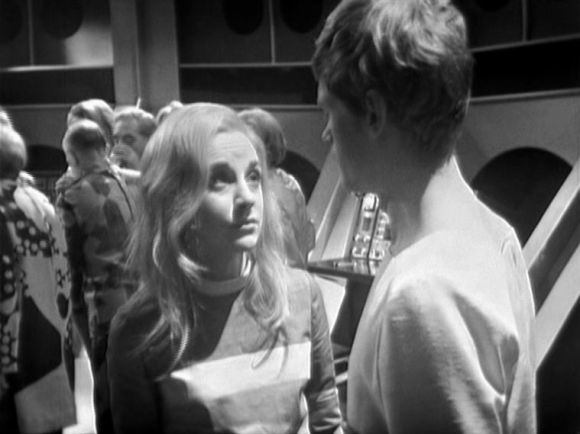The Doctor’s impersonation of Salamander places him in a rather precarious position as Benik doesn’t seem to be totally convinced. But he’s able to authorise the release of Jamie and Victoria and he asks Bruce to take them to the gates to ensure they get away safely. There’s a lovely moment when Bruce asks them to call his deputy Forrester, once they get outside, and tell him that Bruce is at the research station (using the word “redhead”). Jamie wonders if that’s a reference to his wife, but Bruce tells him no, it’s just a code-word. Typical Jamie, always thinking of women!
Once Jamie and Victoria leave they don’t reappear until the the final scene, so this, together with their fairly light appearance in episode five and their absence from episode four, means they’ve hardly featured in the second half of the story. Maybe this is because whilst The Enemy of the World is a good story, it’s not necessarily a good Doctor Who story, so Jamie and Victoria end up rather surplus to requirements. Indeed, you could remove the Doctor as well and it would have been made a very decent one-off serial with Kent and Astrid facing off against Salamander and Benik.
Astrid is able to do little for Swann, but he’s able to tell her the whole story and Astrid ventures underground to tell the workers that Salamander has duped them. She’s only able to take them up two at a time, so she naturally elects to take Colin and Mary (there’s no point taking any of the others, as they’re non-speaking extras!).
For a large part of the story, Kent has insisted that the Doctor should impersonate Salamander in order to find incriminating evidence that will expose him. In the end, this doesn’t happen (and is rather neatly reversed) when Kent meets Salamander (or so he believes) and betrays himself. Kent and the faux-Salamander seem to be trapped in the records room, but Kent knows about the secret exit.
DOCTOR: Well, that’s very interesting, Mr Kent. Why didn’t you tell me that before?
KENT: Oh no, it can’t be.
DOCTOR: Oh, I’m afraid it is. Oh, look. Here’s another surprise for you. Look behind you.
KENT: Astrid, you’ve come just in time.
ASTRID: It’s too late, Giles. I know everything.
COLIN: That’s him. That’s the man who took us down there in the first place.
MARY: Giles Kent. We thought you were dead.
KENT: Now look, I’ve never seen these people before in my life.
ASTRID: They’ve told me everything. You and Salamander were in it together.
The emergence of Astrid at just the right moment (and with two people who can confirm that Kent was Salamander’s partner) is more than a touch contrived, but it works in story terms as it finally strips away the lingering pretence that Giles Kent was on the side of the angels. The Doctor tells him that he was never convinced by him anyway, as “any man who resorts to murder as eagerly and as rapidly as you must be suspect. You didn’t just want to expose Salamander, you wanted to kill him and take his place.” Although Kent may have been more convincing had Bill Kerr played him as a more reasonable and sympathetic character, it’s still a very watchable turn. Best known as Tony Hancock’s idiot friend in the radio version of Hancock’s Half Hour, he also enjoyed a long and successful acting career (some of it spent in the UK) and once of the joys of the recovery of this serial was that we were able once more to enjoy his complete performance.
As previously touched upon, Doctor Who was still a long way away from out-of-order recording, so each episode has to mostly feature Troughton as either the Doctor or Salamander. Since it was the concluding episode, it’s not a surprise that he’s mainly the Doctor, although this means that after building Salamander up throughout the serial, he rather fades away. But he does get to confront his old associate Kent, before his first (and last) encounter with the Doctor.
Had there not been at least one meeting between the Doctor and Salamander, the audience would probably have felt a little cheated (although the Doctor and the Abbot never met in The Massacre). Before that happens though, loose ends are tied up as Bruce and Astrid take charge. Kent has apparently killed both himself and Salamander (via a huge explosion) and the Doctor leaves Astrid as she attempts to rescue the people trapped in the underground shelter.
The final scene is a bit of a cracker. Salamander impersonates the Doctor and he asks Jamie to operate the TARDIS controls. This naturally confuses the Scot, but when the real Doctor makes an appearance, all becomes clear. The Doctor tells Salamander that “we’re going to put you outside, Salamander. No friends, no safety, nothing. You’ll run, but they’ll catch up with you.” After a tussle, Salamander is flung out in the Space/Time vortex and (unusually for the Troughton era) the story closes on a cliff-hanger.
Although The Enemy of the World does have a few logistical issues, there’s plenty to enjoy (especially as it’s such a break from the norm). It was a daring move to tackle a James Bond-type plot with the series’ usual budget (and especially since 95% of the story was shot in the studio) but, apart from the odd wobbly set, it all holds together. Troughton’s great (no matter who he’s playing) and he’s surrounded by some familiar faces (Colin Douglas, George Pravda, Milton Johns) all of whom would appear in later Doctor Whos. Hines and Watling have little involvement in the later part of the story, but Whitaker keeps the story bubbling away so nicely that this never becomes an issue.

















